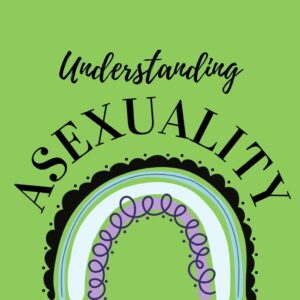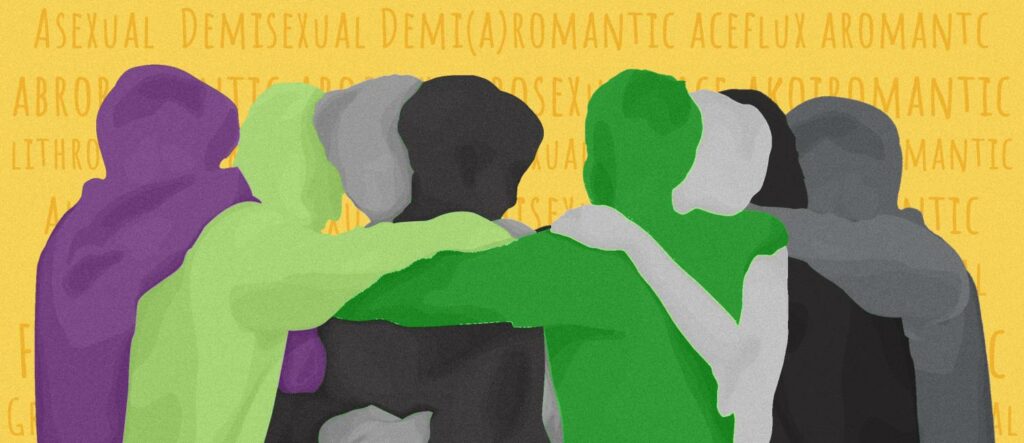In today’s society, the understanding and acceptance of diverse sexual and romantic orientations have become increasingly important. One such aspect is the acknowledgment and recognition of asexuality and aromanticism. In this article, we will explore the concepts of asexuality and aromanticism, debunk common myths, discuss challenges faced by individuals identifying as asexual or aromantic, and highlight the importance of representation and acceptance.
Contents
Understanding Asexuality

Asexuality: Defying societal norms and expectations, asexual individuals experience little to no sexual attraction. It is essential to recognize that asexuality exists on a spectrum, with some individuals identifying as completely asexual, while others may experience occasional or conditional attraction. Asexuality is not a dysfunction or a phase but a valid sexual orientation.
Myths and Misconceptions: Unfortunately, asexuality is often misunderstood or dismissed. Some myths include considering asexuality as a result of trauma, a lack of sexual knowledge, or a hormonal imbalance. These misconceptions invalidate the experiences of asexual individuals and contribute to a lack of understanding in society.
Asexual Identity and Experiences: Asexual individuals have diverse experiences and feelings toward their own identity. Some may choose to be open about their asexuality, while others may face challenges due to the lack of awareness and acceptance. It is crucial to respect an individual’s self-identification and create spaces that support asexual experiences.
Understanding Aromanticism
Aromanticism: Similar to asexuality, aromanticism falls on a spectrum. Aromantic individuals do not experience romantic attraction or may experience it to a lesser degree compared to societal expectations. This orientation challenges the idea that romantic relationships are a universal desire or need.
Myths and Misconceptions: Aromanticism is often misunderstood, with some misconceptions suggesting that aromantic individuals are emotionally cold, incapable of love, or just waiting for the right person. These assumptions disregard the valid experiences of aromantic individuals and perpetuate a limited understanding of romantic orientations.
Aromantic Identity and Experiences: Aromantic individuals may navigate their romantic lives differently from societal norms. Some may choose to prioritize platonic relationships, while others may explore alternative relationship structures that align with their preferences. Understanding and accepting these experiences is vital for creating a more inclusive society.
Asexual and Aromantic Relationships
Asexual and aromantic individuals can form a wide range of relationships that are fulfilling and meaningful. It is crucial to recognize and respect the diversity of relationship dynamics within these communities. Communication, understanding, and consent play significant roles in navigating relationships involving asexual and aromantic individuals.
Types of Relationships: Asexual and aromantic individuals can have various types of relationships, including platonic relationships, queerplatonic partnerships, and non-romantic partnerships. These relationships focus on emotional connection, intimacy, and mutual support, rather than sexual or romantic attraction.
Communication and Understanding: Open and honest communication is key in any relationship, but it becomes even more critical when navigating relationships with asexual and aromantic individuals. Discussing boundaries, expectations, and individual needs can foster understanding and create stronger connections.
Challenges Faced: Asexual and aromantic individuals may face challenges in relationships due to societal expectations and norms. These challenges can include pressure to engage in sexual or romantic activities, difficulty finding compatible partners, and the need for validation and acceptance from others. It is important to offer support and understanding to overcome these obstacles.
Asexual and Aromantic Representation and Acceptance
Asexual and aromantic representation and acceptance have been growing in recent years as awareness and understanding of these identities have increased. Let’s explore each of these topics individually.
Asexual Representation and Acceptance

Asexuality refers to individuals who experience little to no sexual attraction toward others. Representation and acceptance of asexuality have improved significantly, though there is still progress to be made. Some key points include:
- Visibility and Media Representation: Asexual characters and storylines have started appearing in various forms of media, such as TV shows, movies, books, and online content. This representation helps raise awareness and provides a sense of validation to asexual individuals.
- Online Communities and Activism: Asexual individuals have found supportive communities and platforms online to connect with others who share similar experiences. These spaces provide education, resources, and support for asexual people and contribute to greater acceptance.
- Advocacy and Education: Activists, organizations, and educators have been working to raise awareness about asexuality and combat misconceptions and stereotypes. This includes campaigns, workshops, and outreach efforts to promote understanding and acceptance of asexual individuals.
- Inclusion in LGBTQ+ Movements: Asexual representation has been increasingly included within the LGBTQ+ community. The acronym LGBTQIA+ (Lesbian, Gay, Bisexual, Transgender, Queer/Questioning, Intersex, Asexual/Aromantic, and other identities) is becoming more widely used to recognize and include asexual and aromantic individuals.
Aromantic Representation and Acceptance
Aromanticism refers to individuals who experience little to no romantic attraction toward others. While aromantic representation is less common compared to asexuality, efforts to improve understanding and acceptance are underway. Here are some key points:
- Online Communities and Visibility: Aromantic individuals have found solace in online communities, where they can connect with others who understand their experiences. These communities play an essential role in providing support, sharing resources, and fostering acceptance.
- Artistic Expressions and Literature: Aromantic characters and storylines are starting to emerge in various artistic mediums, including books, webcomics, and other forms of storytelling. This representation helps raise awareness and challenges societal norms regarding romance.
- Education and Awareness: Similar to asexual advocacy, there are initiatives focused on educating the public and dispelling myths and misconceptions about aromanticism. These efforts contribute to a greater understanding and acceptance of aromantic individuals.
- Intersectionality and Inclusivity: Recognizing that aromanticism intersects with other identities, such as asexuality, gender identity, and sexual orientation, is important for creating a more inclusive and supportive environment for all individuals.
Overall, while progress has been made, it’s essential to continue advocating for asexual and aromantic representation and acceptance. By promoting understanding, challenging stereotypes, and supporting diverse identities, we can work towards a more inclusive society for all individuals, regardless of their sexual or romantic orientation.
Challenges and Misunderstandings
Despite the progress made in asexual and aromantic representation and acceptance, there are still challenges and misunderstandings that exist. Here are some common ones:
- Lack of Awareness and Visibility: A major challenge is the lack of awareness and understanding of asexuality and aromanticism. Many people are unfamiliar with these identities, leading to misunderstandings and stereotypes. This lack of visibility can make it difficult for asexual and aromantic individuals to feel understood and accepted.
- Misconceptions and Stereotypes: Asexuality and aromanticism are often met with misconceptions and stereotypes. Some common misunderstandings include assuming asexuality is a result of past trauma, seeing asexuality as a medical or psychological problem, or perceiving aromantic individuals as emotionally detached or incapable of forming meaningful relationships. These misconceptions can contribute to stigma and discrimination.
- Pressure and Invalidation: Asexual and aromantic individuals may face pressure to conform to societal norms surrounding sex, relationships, and romance. This pressure can come from family, friends, or society as a whole. Moreover, their identities may be invalidated, dismissed, or seen as less valid compared to other sexual orientations and romantic orientations.
- Lack of Representation in Media: While there has been progress in media representation, asexual and aromantic characters are still underrepresented. This lack of representation can perpetuate a sense of isolation and make it challenging for individuals to see themselves and their experiences reflected in popular culture.
Overcoming Stigma and Celebrating Diversity

Overcoming stigma and celebrating diversity are essential steps toward creating a more inclusive and accepting society for asexual and aromantic individuals. Here are some strategies and approaches that can help:
- Education and Awareness: Education plays a vital role in dispelling misconceptions and increasing understanding. Promote accurate information about asexuality and aromanticism through educational initiatives, workshops, and awareness campaigns. Encourage discussions in schools, workplaces, and community settings to foster dialogue and challenge stereotypes.
- Representation in Media: Advocate for increased representation of asexual and aromantic characters in various forms of media, including TV shows, movies, books, and online content. Encourage diverse and authentic portrayals that depict the experiences and diversity within the asexual and aromantic communities.
- Intersectional Approaches: Recognize and address the intersectionality of asexual and aromantic identities with other marginalized aspects, such as race, gender, disability, or cultural background. Understand the unique challenges faced by individuals who navigate multiple identities and ensure inclusivity in advocacy and support efforts.
- Supportive Communities: Create and foster supportive communities both online and offline for asexual and aromantic individuals. These spaces can provide a sense of belonging, support, and validation. Encourage peer support networks, discussion forums, and social groups where individuals can share experiences and find understanding.
- Challenging Stereotypes: Encourage open conversations that challenge stereotypes and misconceptions about asexuality and aromanticism. Encourage active listening, empathy, and understanding. By providing accurate information and personal stories, we can help break down barriers and foster acceptance.
- Allyship and Solidarity: Encourage allies to show support for asexual and aromantic individuals. Allies can educate themselves about these identities, actively challenge stigmatizing attitudes, and promote inclusivity in their personal and professional lives. Encouraging solidarity within the broader LGBTQ+ community can also help create a more supportive environment.
- Celebrating Diversity: Embrace and celebrate the diversity within the asexual and aromantic communities. Recognize that experiences and identities can vary widely, and avoid making assumptions or generalizations. Respect individual choices regarding relationships, romance, and personal boundaries.
Conclusion
Understanding and embracing asexuality and aromanticism are essential steps toward building a more inclusive and accepting society. By challenging stereotypes, promoting education, and fostering dialogue, we can create spaces that validate the experiences of asexual and aromantic individuals, celebrating the diversity of human relationships.
Life may sometimes be challenging for asexuals, but Online Asexual Counseling can help. Get experienced LGBTQ therapists at PrideMantra: Book a trial LGBTQ therapy session.


